The Ultimate Guide to the Longmen Grottoes: Discovering Ancient Artistry in Luoyang, China
An Essential Guide to Visiting Longmen Grottoes
Nestled in the serene hills of Luoyang, China, the Longmen Grottoes offer a breathtaking tapestry of ancient artistry that speaks to the soul of humanity. This UNESCO World Heritage Site is renowned for its staggering collection of over 100,000 Buddhist statues and carvings, intricately etched into the limestone cliffs that stretch for a kilometer along the Yi River. These masterpieces, created over 1,500 years ago, are not only a testament to the artistic prowess of early Chinese civilization but also an enduring symbol of spiritual devotion.
In this essential guide, we’ll explore everything you need to know to make the most of your visit to the Longmen Grottoes. From practical travel tips on how to get there, to highlights of the most significant caves such as Binyang Caves, Wanfo Cave, and Fengxian Temple, we’ll ensure you don’t miss any of the site’s treasures. You’ll also find insights on the best times to visit, accessibility options, and recommendations for nearby attractions to enhance your experience. Prepare to embark on a journey through time, where art and history converge in one of China’s most awe-inspiring destinations.
In This Guide
- An Essential Guide to Visiting Longmen Grottoes
- The Rich History and Legends of Longmen Grottoes
- Main Highlights: What You Absolutely Can’t Miss
- Planning Your Visit: A Practical Guide
- Tickets: Prices, Booking, and Tips
- How to Get There: A Complete Transportation Guide
- Local Cuisine and Accommodation Nearby
- Frequently Asked Questions
- Final Thoughts on Your Trip
The Rich History and Legends of Longmen Grottoes
The Origins of Longmen Grottoes
The Longmen Grottoes, a breathtaking testament to ancient artistry, trace their origins back to the Northern Wei Dynasty, around 493 AD. This significant period in Chinese history was marked by the consolidation of Buddhism, which became a central theme in the art and culture of the era. As the dynasty sought to legitimize its rule, the creation of these grottoes served both a spiritual purpose and a political one, showcasing the power of the state in commissioning grand art projects.
Over the centuries, the site flourished, with successive dynasties adding their own touches. The Sui and Tang dynasties, in particular, played vital roles in expanding the grottoes, leading to the creation of thousands of statues and inscriptions that reflect the evolution of Buddhist iconography. By the end of the Tang Dynasty, the Longmen Grottoes had become one of the four great ancient grottoes of China, alongside the Mogao Caves, Yungang Grottoes, and Maijishan Grottoes.
A Flourishing Artistic Legacy
As you wander through the grottoes, the artistic legacy of various dynasties is evident. The intricate carvings, which number over 100,000, showcase not only the craftsmanship of ancient artisans but also the cultural exchanges between China and neighboring regions. This artistic melting pot is reflected in the diverse styles and techniques displayed, from the graceful depictions of Buddha to the elaborate bodhisattvas and guardian figures.
The most notable sections of the Longmen Grottoes include the Binyang Caves, Wanfo Cave, and the magnificent Fengxian Temple, which houses a colossal statue of Vairocana Buddha, flanked by attendants and bodhisattvas. The grandeur of these sites is a testament to the heights of Buddhist art during the Tang Dynasty, often regarded as a golden age for Chinese sculpture.
Legends and Myths
The Longmen Grottoes are steeped in legends that add a mystical layer to their historical significance. One such tale tells of the legendary monk, Xuanzang, who traveled to India to retrieve sacred Buddhist texts. It is said that upon his return, he visited the grottoes, where he was inspired to create the intricate sculptures that adorn the cliffs. His journey symbolizes the quest for knowledge and enlightenment, resonating deeply within the spiritual context of the site.
Another popular legend speaks of the Dragon Gate (Longmen) itself, from which the grottoes derive their name. According to the myth, a dragon once lived in the Yi River, and it would occasionally rise to the surface to protect the local villagers from harm. The grottoes were thus created as a sanctuary for the dragon, and it is believed that the spirits of the dragon still watch over the site, blessing those who visit with peace and tranquility.
Recognition and Preservation
In 2000, the Longmen Grottoes were designated a UNESCO World Heritage Site, recognized for their outstanding representation of human artistic creativity. This status not only acknowledges the historical and cultural significance of the grottoes but also emphasizes the need for their preservation in the face of modern threats. Efforts continue to protect this invaluable heritage site, ensuring that future generations can marvel at the intricate carvings and the stories they tell.
Visiting the Grottoes Today
Today, visitors flock to the Longmen Grottoes to witness this remarkable blend of art, history, and legend. The site invites travelers to connect with the past, offering a glimpse into the spiritual and cultural richness of ancient China. As you explore the serene landscapes and magnificent sculptures, the echoes of history and the whispers of legends come alive, making each visit an unforgettable experience.
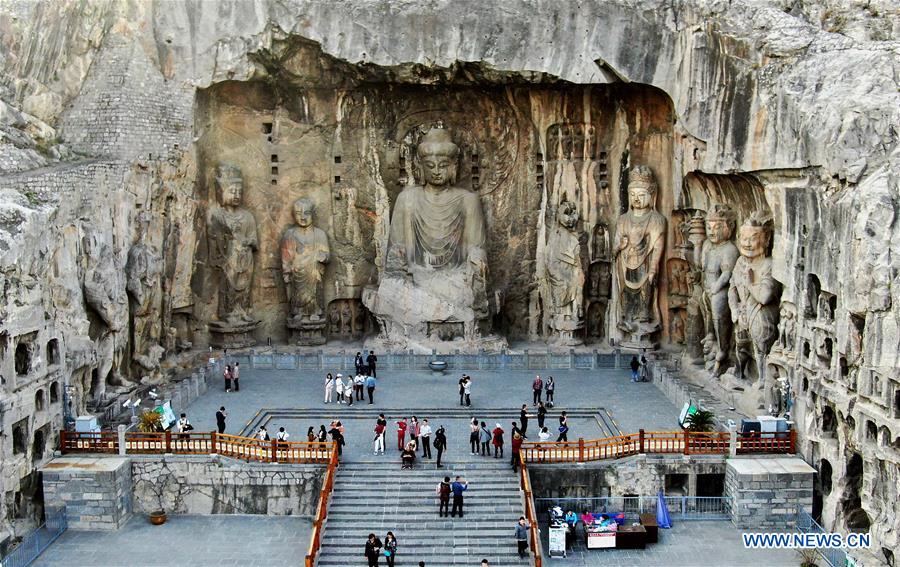
Longmen Grottoes.
Main Highlights: What You Absolutely Can’t Miss
Binyang Caves
Nestled in the heart of the Longmen Grottoes, the Binyang Caves are a trio of interconnected caves renowned for their impressive array of Buddhist statues and intricate carvings. Carved during the Northern Wei Dynasty, these caves feature a stunning main Buddha statue, flanked by serene bodhisattvas. The artistry here reflects the height of Buddhist sculpture, showcasing the delicate details and spiritual expressions that have captivated visitors for centuries.
Tip: Allow yourself ample time to wander through each cave and appreciate the subtleties of the carvings. The light filtering through the openings enhances the ethereal atmosphere, so visit in the morning for the best experience.
Fengxian Temple
The grand Fengxian Temple is arguably the crown jewel of the Longmen Grottoes. Home to the colossal Vairocana Buddha, this temple’s main statue soars to an impressive height of 17 meters. Surrounding this magnificent figure are intricately carved attendants and historical figures, each telling a story of devotion and artistry. The temple’s design is a remarkable fusion of scale and elegance, making it a must-see for any traveler.
Tip: Bring a camera with a good zoom lens to capture the intricate details of the carvings from a distance, as the temple can get quite crowded. Visiting early in the day can also help you avoid the throngs of tourists.
Wanfo Cave
The Wanfo Cave, or “Ten Thousand Buddha Cave,” is a mesmerizing site filled with over 15,000 small Buddha statues, each one unique and intricately designed. The atmosphere here is profound, as the sheer number of figures creates a sense of spiritual abundance. This cave exemplifies the dedication of the artisans who worked tirelessly to create such a vast collection of sculptures.
Tip: Look closely at the different facial expressions and postures of the Buddhas; each carries its own significance. For a unique perspective, try visiting during the late afternoon when the light casts beautiful shadows across the cave.
East Hill Area: Xiangshan Temple
While the West Hill is home to most of the iconic carvings, the East Hill offers a quieter retreat at Xiangshan Temple. This temple, with its tranquil courtyards and vibrant painted ceilings, provides a peaceful contrast to the bustling grottoes. Strolling through the serene gardens and enjoying the harmonious architecture is a perfect way to unwind after your explorations.
Tip: Don’t miss the chance to partake in a moment of meditation in the temple’s courtyards; it’s a wonderful spot to reflect on the beauty of your surroundings.
Longmen Aquarium
After immersing yourself in the spiritual ambiance of the grottoes, head over to the Longmen Aquarium for a different kind of tranquility. This modern attraction features a variety of aquatic life, bringing a splash of color and life to your visit. It provides a delightful contrast to the ancient artistry you’ve just explored.
Tip: The aquarium is particularly family-friendly, so if you’re traveling with children, this is a great way to keep them engaged. Plan your visit to coincide with feeding times for an exciting experience!
The Scenic Walk
To fully appreciate the grandeur of the Longmen Grottoes, take a leisurely stroll along the scenic pathways that line the Yi River. The natural beauty of the area, combined with glimpses of the carvings tucked into the cliffs, creates an unforgettable experience. This leisurely walk allows you to reflect on the artistry and history of the site while enjoying the lush surroundings.
Tip: Bring comfortable walking shoes and a water bottle, as the paths can be uneven and may require some stamina. Early morning or late afternoon walks are particularly pleasant, avoiding the peak heat of the day.
Optional: Evening Light Show
If time permits, consider staying for the evening light show that illuminates the grottoes. The carvings are beautifully lit against the night sky, creating a magical atmosphere that highlights their intricate details in a whole new light. This experience adds an unforgettable dimension to your visit.
Tip: Check the local schedule for showtimes and arrive early to secure a good viewing spot. The combination of history, art, and light makes for a truly enchanting experience.
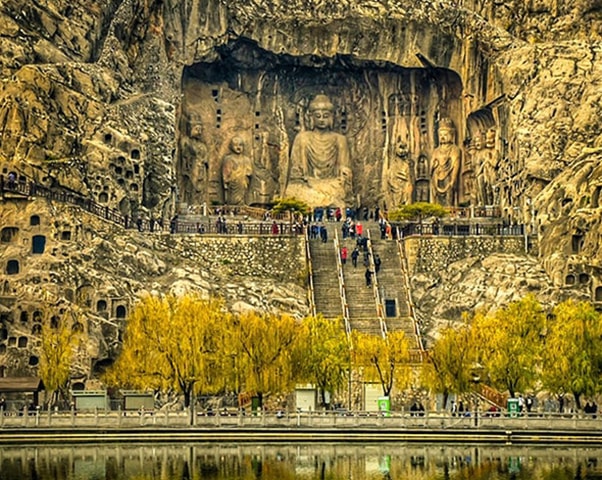
Longmen Grottoes.
Planning Your Visit: A Practical Guide
Best Time to Visit
The Longmen Grottoes can be enjoyed year-round, but the ideal times to visit are during the spring (April to June) and autumn (September to November) months. During these seasons, the weather is mild, with temperatures ranging between 15°C to 25°C (59°F to 77°F), making it pleasant for walking and exploring the site. Avoid the peak summer months (July and August) when temperatures can soar above 35°C (95°F) and humidity levels climb, making your visit uncomfortable.
Recommended Itinerary
To maximize your experience at the Longmen Grottoes, here’s a suggested itinerary:
Morning
– 8:00 AM: Arrive early to beat the crowds and the heat.
– 8:30 AM – 10:30 AM: Start your exploration at the West Hill, where the most impressive carvings, including the Binyang Caves and the Fengxian Temple, are located.
Lunch
– 11:00 AM: Enjoy a lunch break at nearby restaurants or pack a picnic to enjoy at Baiyuan Park.
Afternoon
– 12:30 PM – 2:30 PM: Visit the East Hill, including Xiangshan Temple, which offers a quieter and more serene atmosphere. Take some time to appreciate the beautiful gardens of Baiyuan Park.
Wrap Up
– 3:00 PM: If time permits, explore nearby attractions such as the Guanlin Temple or the Longmen Aquarium.
Photography Tips
-
Golden Hour: The best light for photography occurs during the golden hour—early morning or late afternoon. This will enhance the textures of the carvings and provide a beautiful backdrop.
-
Avoid Crowds: Visit during weekdays and early in the morning to capture photos without the throng of tourists.
-
Use a Tripod: If you’re serious about photography, consider bringing a lightweight tripod for stability, especially in low-light situations.
-
Capture Details: Don’t just shoot wide-angle shots of the grottoes; zoom in on intricate details of the carvings and inscriptions to highlight their craftsmanship.
-
Respect No-Flash Zones: Be mindful of any restrictions on flash photography, as it can damage the delicate limestone.
What to Wear
Dress comfortably and practically for your visit:
- Footwear: Wear sturdy, comfortable shoes suitable for walking on uneven terrain.
- Clothing: Lightweight, breathable clothing is recommended, especially during warmer months. Consider a hat and sunglasses for sun protection.
- Layers: In cooler months, bring layers, as temperatures can drop in the late afternoon.
Insider Tips
-
Plan for a Full Day: While the main attractions can be seen in a few hours, allow extra time to wander and absorb the atmosphere, especially if you visit during the quieter hours.
-
Bring Water: Ensure you stay hydrated, particularly in hotter months. There are limited facilities inside the grottoes, so bring your reusable water bottle.
-
Explore Nearby Attractions: If you have additional time, consider visiting the nearby Shaolin Temple, known for its martial arts, or other historical sites in Luoyang, as they complement the cultural experience.
-
Check for Night Tours: Some visitors recommend the Longmen Grottoes night tour, which showcases the carvings illuminated by lights, creating a magical and less crowded experience.
-
Use Local Guides: If possible, hire a local guide who can provide deep insights into the history and significance of the carvings, enriching your visit further.
By following this practical guide, you’re bound to have an enriching and memorable visit to the Longmen Grottoes, one of China’s most fascinating historical treasures. Happy travels!
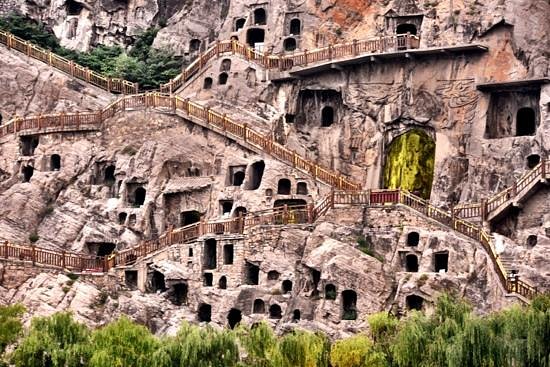
Longmen Grottoes.
Tickets: Prices, Booking, and Tips
Visiting the Longmen Grottoes is a must for anyone interested in history, art, and culture. Before you embark on your journey to this UNESCO World Heritage site, here’s all the essential information regarding tickets, pricing, and booking tips.
Ticket Information
| Ticket Type | Price (CNY) | Includes |
|---|---|---|
| Standard Entry Ticket | 90 | Access to the grottoes and main areas |
| Longmen Grottoes Entry Ticket with Optional Guide | 140 | Entry plus a guided tour |
| Private Half-Day Tour | 700 | Entry, guide, and transportation |
| Full Day Tour (including Shaolin Temple) | 1,800 | Entry, guide, transportation, and lunch |
Booking Your Tickets
Booking your tickets in advance is highly recommended to ensure a smooth visit, especially during peak travel seasons. Here are a few steps to secure your entry:
- Online Booking: The easiest way to book your tickets is through official tourism websites or reputable travel platforms, which often provide options for guided tours and private transfers.
- On-site Purchase: While you can buy tickets at the entrance, be prepared for long queues, particularly on weekends and holidays.
- Tour Packages: Consider booking a tour that includes transportation from major cities like Xi’an or Luoyang, which often covers entry fees and provides a knowledgeable guide.
Tips for a Great Visit
- Plan Ahead: Aim to book your tickets at least a few days in advance, especially if you want a guided experience.
- Visit Early or Late: To avoid the crowds and enjoy a more serene atmosphere, consider visiting early in the morning or later in the afternoon.
- Check Opening Hours: The grottoes typically open at 8:00 AM and close at 6:00 PM, but these times can vary, especially during holidays or inclement weather.
By following these guidelines, you can ensure a memorable visit to the Longmen Grottoes, immersing yourself in the awe-inspiring beauty of ancient Chinese artistry.
How to Get There: A Complete Transportation Guide
From the Nearest Major City
Arriving from Luoyang
Getting to the Longmen Grottoes from downtown Luoyang is quite straightforward, and you have a couple of convenient options.
By Private Car:
– Distance: Approximately 8 kilometers from Luoyang Longmen Railway Station and about 18 kilometers from Luoyang Railway Station.
– Duration: A drive takes around 18 minutes from Longmen Railway Station and about 30 minutes from Luoyang Railway Station.
– Cost: Typically varies based on the service provider, but expect around RMB 100-200 (USD 14-28) for a private transfer.
By Bus:
– Route: Take Bus 81, which offers a direct ride to the Longmen Grottoes.
– Duration: The bus ride lasts approximately 50 minutes.
– Cost: A one-way ticket costs RMB 1.5 (USD 0.2).
This option is budget-friendly and allows you to experience local life as you travel.
Traveling from Xi’an
If you’re coming from Xi’an, the high-speed train is your best bet.
By High-Speed Train:
– Departure Point: Xi’an North Station.
– Duration: The journey takes about 1.5 hours to Luoyang Longmen Station.
– Frequency: Trains run frequently, especially in the morning, with departures around 7 to 8 AM recommended for a day trip.
– Cost: Ticket prices typically range from RMB 150-250 (USD 21-35) depending on the class.
Once you arrive at Luoyang Longmen Station, you can easily arrange a private car for the short drive to the grottoes, which takes about 18 minutes. Trains back to Xi’an are available until about 9 PM, giving you ample time to explore.
Getting Around the Scenic Area
The Longmen Grottoes span both sides of the Yi River and are divided into two main sections: West Hill and East Hill.
Exploring West Hill
Most of the impressive carvings and sculptures are located on West Hill, making this area the focal point for visitors. Expect to spend a significant amount of time here, as you’ll want to marvel at the intricate details of the numerous Buddhas and Bodhisattvas carved into the limestone cliffs.
Discovering East Hill
While West Hill is the primary attraction, the East Hill is home to Xiangshan Temple and Baiyuan Park, providing a quieter atmosphere.
– Xiangshan Temple: Offers peaceful courtyards and beautifully painted ceilings, perfect for a leisurely stroll.
– Baiyuan Park: A traditional Jiangnan-style garden honoring the Tang poet Bai Juyi, ideal for those looking to relax after exploring the grottoes.
Tips for Getting Around
- Walking: The grottoes are best explored on foot. Wear comfortable shoes, as the paths can be uneven and require some climbing.
- Guided Tours: Consider joining a guided tour to gain deeper insight into the historical and cultural significance of the grottoes. Many tours offer convenient transportation from nearby cities, making your visit seamless.
With these travel options and tips, your journey to the Longmen Grottoes will be both enjoyable and memorable!
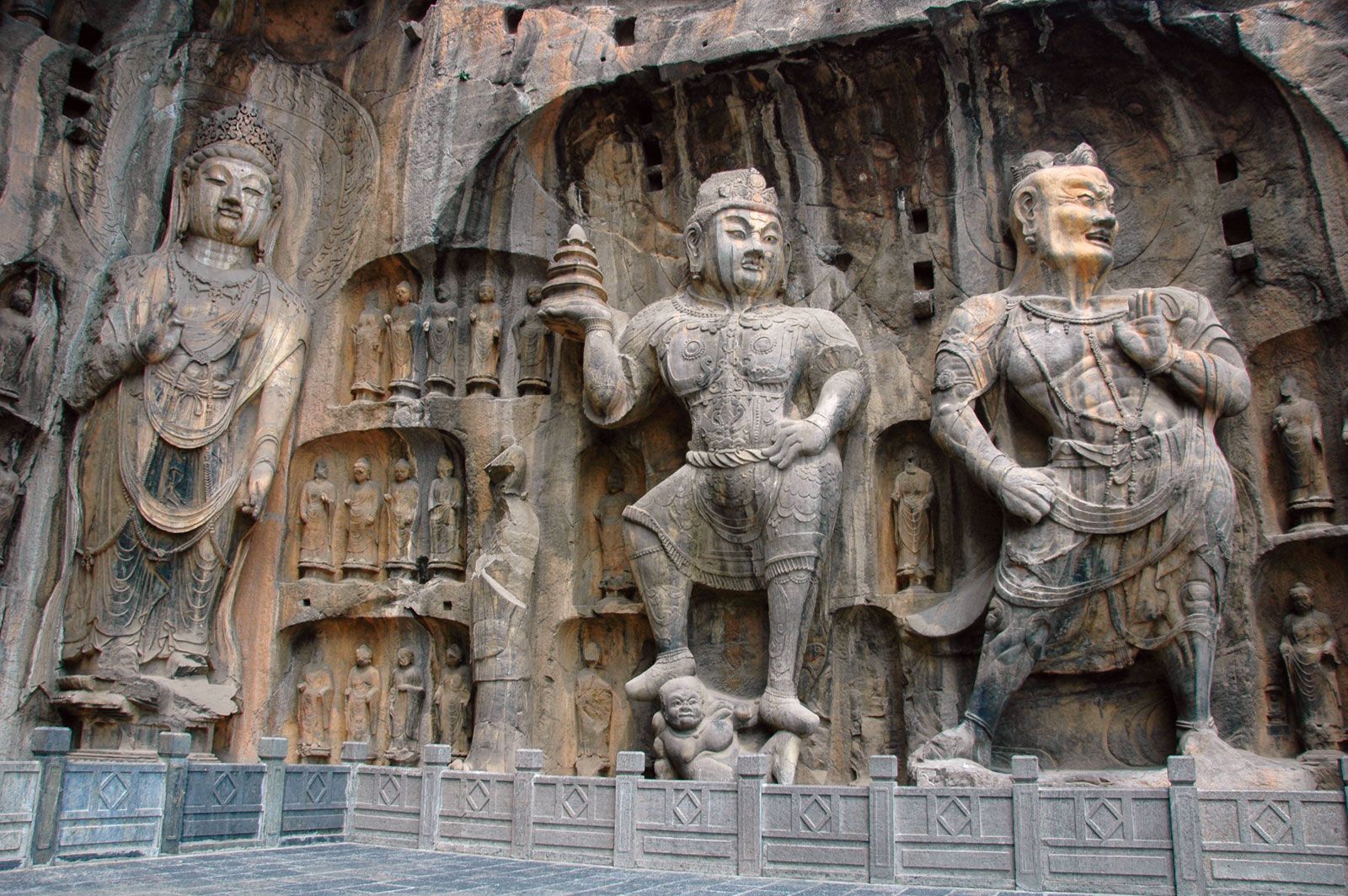
Longmen Grottoes.
Local Cuisine and Accommodation Nearby
After immersing yourself in the breathtaking artistry of the Longmen Grottoes, you’ll certainly want to explore the local culinary delights and find a comfortable place to rest. Luoyang, with its rich cultural heritage, offers a variety of traditional dishes and accommodations to suit every traveler’s needs.
Culinary Delights
-
Luoyang Water Banquet (洛阳水席)
This iconic meal consists of a series of dishes, all featuring a delightful broth. It typically includes about 24 different courses, with the centerpiece being a delicate soup accompanied by various side dishes like steamed buns and pickled vegetables. The banquet is not just a meal; it’s a culinary journey that showcases the region’s flavors and traditions. -
Stewed Noodles (洛阳牛肉汤)
A must-try for noodle lovers, Luoyang’s stewed noodles are made from hand-pulled wheat noodles served in a savory broth, often enriched with tender beef slices and a sprinkle of green onions. This comforting dish is perfect for a hearty lunch after a morning spent exploring the grottoes. -
Cold Noodles (凉皮)
Perfect for hot summer days, these cold noodles are made from wheat or rice flour and served with a tangy sauce made from vinegar, soy sauce, and garlic. Topped with sliced cucumbers, bean sprouts, and sometimes shredded chicken, this dish is refreshing and satisfying. -
Luoyang Peony Cake (洛阳牡丹饼)
This traditional pastry is shaped like the peony flower, symbolizing prosperity. Filled with sweet red bean paste or savory fillings, these cakes make for a delightful snack or dessert, embodying the essence of Luoyang’s rich floral heritage.
Where to Stay
Luxury Accommodation
– Luoyang Longmen Hotel (龙门酒店)
Located just a short drive from the Longmen Grottoes, this luxurious hotel offers elegant rooms with modern amenities. Enjoy their on-site spa and fine dining options, providing a serene escape after a day of exploration.
Boutique Option
– The Silk Road Boutique Hotel (丝绸之路精品酒店)
A charming boutique hotel that merges traditional Chinese architecture with modern comforts. Each room is uniquely designed, reflecting the local culture. The hotel also features a cozy café where guests can enjoy local snacks and beverages.
Budget-Friendly Choice
– Luoyang Youth Hostel (洛阳青年旅舍)
Perfect for backpackers and budget travelers, this hostel offers clean, dormitory-style accommodations at an affordable price. It’s located within walking distance of several local eateries and is a great place to meet fellow travelers.
Family-Friendly Hotel
– Holiday Inn Luoyang (假日酒店)
This family-oriented hotel provides spacious rooms and convenient amenities, including an indoor pool and a children’s play area. Its location is ideal for families looking to explore the Longmen Grottoes and nearby attractions with ease.
With these delectable local dishes and comfortable lodging options, your visit to the Longmen Grottoes will be as enriching and enjoyable as the site itself. Embrace the flavors and hospitality of Luoyang as you delve into its cultural treasures!
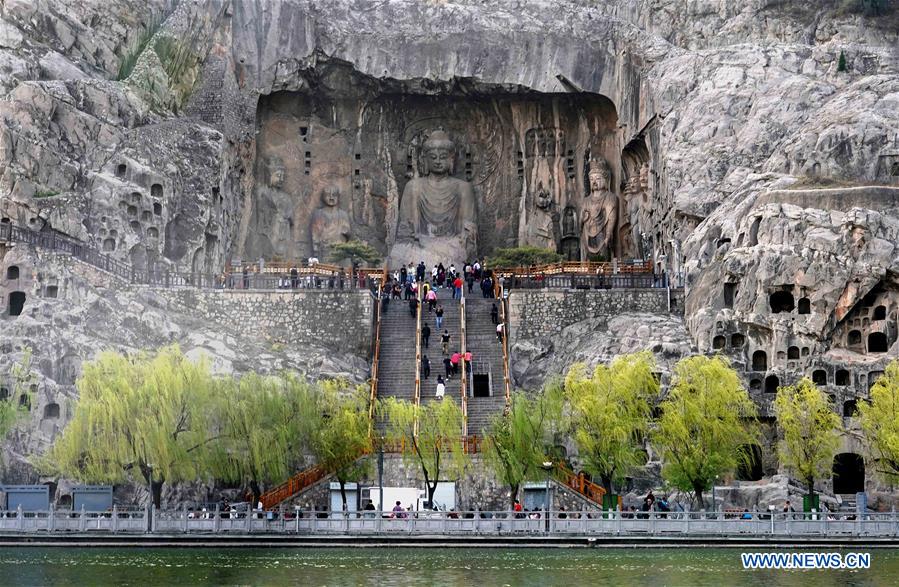
Longmen Grottoes.
Frequently Asked Questions
Frequently Asked Questions about Longmen Grottoes
1. Is Longmen Grottoes suitable for children and the elderly?
Yes, Longmen Grottoes is generally suitable for children and the elderly, but visitors should be prepared for some walking and climbing. The paths are well-maintained, though some areas may have uneven surfaces. It’s advisable to wear comfortable shoes and take breaks if needed.
2. How much time should I plan to spend at Longmen Grottoes?
Most visitors typically spend around 3 to 4 hours exploring the grottoes. This allows enough time to appreciate the intricate carvings, visit key sites like Binyang Caves and Fengxian Temple, and enjoy the scenic surroundings. If you wish to explore more leisurely or visit nearby attractions, consider allocating a full day.
3. Are there English signs and information available?
Yes, there are English signs throughout the grottoes, providing information about the history and significance of various sculptures and caves. Additionally, you can hire an English-speaking guide for a more in-depth understanding of the site.
4. What is the best time of year to visit Longmen Grottoes?
The best time to visit is during spring (April to June) and autumn (September to November) when the weather is mild and pleasant. Summer can be quite hot and humid, while winter may bring cold temperatures. Always check the weather forecast before your visit.
5. How do I get to Longmen Grottoes from Luoyang?
Longmen Grottoes is located about 8 kilometers from downtown Luoyang. You can reach it by private car, taxi, or public bus (Bus 81), which takes approximately 50 minutes. If you’re traveling from Xi’an, take the high-speed train to Luoyang Longmen Station, which takes about 1.5 hours.
6. Is there an entrance fee for Longmen Grottoes?
Yes, the entrance fee is approximately RMB 90 (around USD 12.5). It’s advisable to carry cash as some vendors may not accept credit cards. Check for any discounts for students or groups when purchasing your tickets.
7. Are food and restrooms available on-site?
Yes, there are food stalls and restaurants nearby, as well as restroom facilities within the scenic area. However, options may be limited, so consider bringing snacks and water, especially if you’re visiting during peak hours.
8. Is Longmen Grottoes wheelchair accessible?
While some areas of Longmen Grottoes are accessible for those with mobility challenges, the majority of the site involves steps and uneven paths. It’s advisable to check with the management for specific wheelchair access points and consider bringing a companion to assist if needed.
Final Thoughts on Your Trip
As you wrap up your journey through the Longmen Grottoes, take a moment to reflect on the incredible artistry and history that surrounds you. Standing before the thousands of intricately carved Buddhas and the serene expressions captured in stone, you can’t help but feel a deep connection to the past. Each sculpture tells a story, echoing the devotion and creativity of artisans who dedicated their lives to crafting this monumental site over 1,500 years ago.
Beyond the breathtaking visuals, the Longmen Grottoes offer a unique window into the spiritual and cultural tapestry of China. It’s a place where art, history, and faith intertwine, inviting you to ponder the shared human experience across time and geography.
As you leave, carry with you the tranquility of the Yi River and the whispers of ancient prayers that linger in the air. Let the beauty of the Grottoes inspire you to seek out the stories and artistry in every destination you visit. Remember, every journey is a chance to explore not just new landscapes, but new perspectives as well. Safe travels!